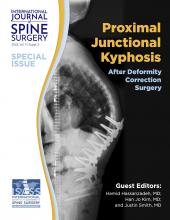The International Journal of Spine Surgery is honored to provide a special issue on the topic of proximal junctional kyphosis (PJK) in deformity surgery. Many spine surgeons are all too familiar with the occurrence of PJK without being familiar with ways to avoid it. Despite years of research and resources that have been geared toward investigating the etiology, clinical impact, and treatment of PJK, the only consensus we have is that there is no consensus on how to effectively stop PJK.
Within this special issue, we have assembled some of the most prolific key opinion leaders in spinal deformity surgery and PJK to provide a resource for spine surgeons to orient themselves to the current state-of-the-art thinking on topics relevant to PJK. The first article provides a thorough review of clinically relevant vs asymptomatic PJK, and the second provides an excellent review of the costs associated with PJK , the impact these costs can have on deformity surgery, and the financial burden it can pose.
Several articles that follow review the methods utilized in PJK prevention. PJK has been attributed to issues related to bone quality, soft tissue, malalignment, and construct-related factors, in addition to more sophisticated patient factors including sarcopenia and overall frailty. Although all of these factors have been associated with PJK incidence, modification of these factors in isolation has provided little in the way of effective PJK prevention. We realize that PJK is a multifactorial problem that likely has a multifactorial solution. Thus, this issue provides a review of methods for PJK prevention, starting with the optimization of patient-related factors, the utility of tethers, alignment considerations, proximal fixation strategies at the upper instrumented vertebrae (UIV), and minimally invasive strategies. A combination of all of these prevention strategies may result in risk mitigation for PJK.
When PJK does occur, the treatment can vary from radiographic follow-up to revision surgery. Often, revision surgery for PJK results in recurrent PJK. Unfortunately, the incidence of recurrent PJK after revision for PJK is high. This special issue concludes with a review of current strategies for PJK revision and the role of addressing residual deformity within prior constructs.
We hope this issue delivers a comprehensive summary of the current state of research around PJK and provides a foundation for the spine surgeon community in novel ways to think about PJK to eventually develop methods for successful prevention.
Footnotes
Funding The authors received no financial support for the research, authorship, or publication of this article.
Declaration of Conflicting Interests Dr. Hassanzadeh is a paid consultant and presenter/speaker for Nuvasive and Orthofix; has stock/stock options for that Nuvasive; and receives research support from Orthofix. Dr. Kim discloses that he receives royalties from Zimmer Biomet, Surgical Acuity, and K2M-Stryker; is a consultant for NuVasive; and receives support for a nonstudy-related clinical or research effort that he oversees from the International Spine Study Group Foundation (ISSGF) and SI-Bone. Dr. Smith reports consultancy fees from ZimVie, NuVasive, Cerapedics, SeaSpine, and Carlsmed; receives royalties from Zimmer Biomet and NuVasive; holds stock in Alphatec and NuVasive; receives research funding to his institution from DePuy Synthes, ISSGF, and AOSpine; and receives fellowship grant funding to his institution from AOSpine.
- This manuscript is generously published free of charge by ISASS, the International Society for the Advancement of Spine Surgery. Copyright © 2023 ISASS. To see more or order reprints or permissions, see http://ijssurgery.com.







